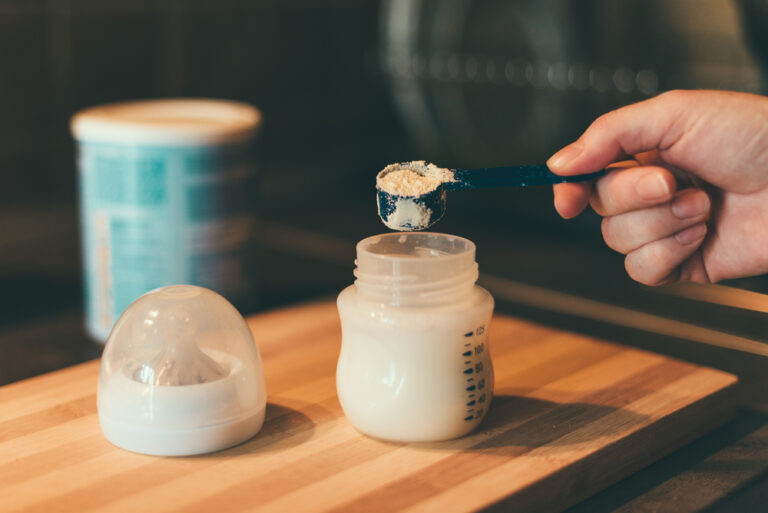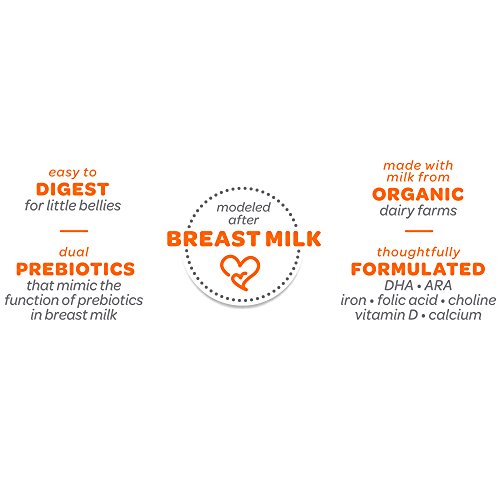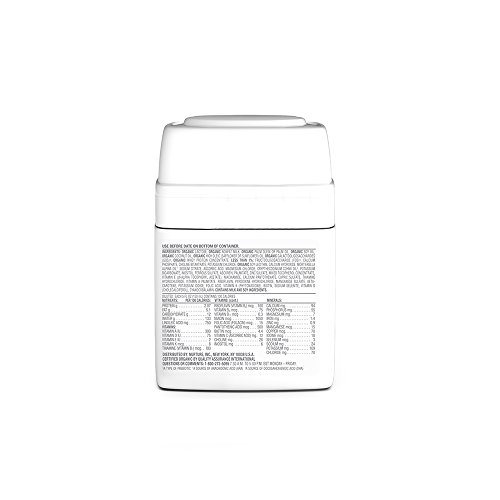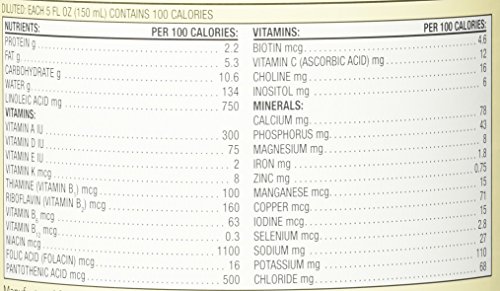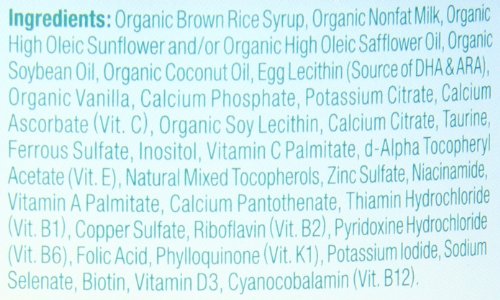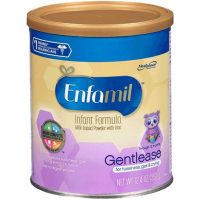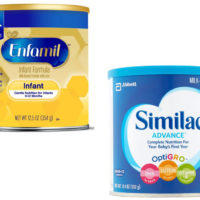Editor’s Note
As of May 2022, many formulas have become increasingly difficult to find. Please read our article, What To Do If You Can’t Find Baby Formula, for more information regarding the formula shortage.
I wish there were an infant formula that met all of the needs for each and every baby. Unfortunately, that just doesn’t exist. Each baby responds differently to a particular formula, so what works for one might not work for another. The best organic baby formula will depend entirely on your infant’s tastes, sensitivities, and nutritional needs. I’ve picked the best organic baby formula options to give you a good starting point for feeding your baby.
Conventional vs Organic Baby Formula: What’s the difference?
Organic formula has become increasingly popular. Many parents see it as a healthier option for their baby. Before its availability in the U.S, some parents purchased these formulas from other countries. Although all infant formulas must meet the ESPGHAN international standards, U.S. health authorities have expressed concern about product tampering and safety when purchased from third party vendors (source). Fortunately, there are now a variety of FDA-approved organic infant formulas manufactured domestically.
Most of these formulas contain organic cow’s milk. In order to receive a “certified organic” label, the cows from which the milk is sourced must not be treated with hormones, antibiotics, or synthetic chemicals (source). There are also not subjected to genetic modification. As for nutritional differences, some studies have shown that organic cow’s milk has more linoleic acid and vitamin E than non-organic milk (source). Linoleic acid is a component of breastmilk that is important for the formation of DHA. These fatty acids are important for infant brain development, so their presence in a formula is ideal. Organic cows who have been fed fish oil may produce milk that is higher in DHA. However, aside from this higher essential fatty acid content, there are no significant differences in the nutritional value of organic and conventional infant formulas (source).
In addition to cow’s milk options, there are a few formulas made with organic goat’s milk or soy protein. Organic goat’s milk infant formulas, however, are not manufactured in the United States. Unlike conventional soy infant formulas, only non-GMO soybeans are used (source). The soybeans are also free of “washing” with hexane or other chemicals.
Best Organic Formulas for Your Baby
Happy Baby Organics Formula is a great organic choice that does not use corn syrup or any sweetners, while Similac Organic Formula actually uses sugar to sweeten the formula.
Happy Baby Organic Infant Formula Milk-Based Powder with Iron
I frequently bought Happy Baby’s pureed food pouches for my son, and I was never disappointed. They make quality organic options for babies and toddlers that taste good, and have great ingredients. Their Happy Baby Organic Infant Formula Milk-Based Powder with Iron is no exception.
I also love that this company was founded and is operated by fellow moms.
In addition to a quality infant formula, Happy Baby offers free one-on-one chats with dieticians and lactation specialists. The interactions are completely anonymous. They just answer questions, and provide guidance on nutrition and product usage. I definitely recommend this service!
What I Like
Since the company founders are mamas, they know a thing or two about breast milk: what’s in it, what it tastes like, and how important it is. They used this knowledge to design an infant formula that is as close to breast milk as possible. They also believe that the healthiest baby formula is made with organic, farm-raised cow’s milk. It provides both protein and lactose, the main carbohydrate in breast milk.
This formula includes DHA and ARA, those essential fatty acids, as well as the vitamins and minerals found in abundance in breast milk. The best additions, however, are two prebiotics: GOS and FOS. These oligosaccharides mimic the prebiotics found in breast milk that help babies maintain healthy gut bacteria. These aide digestion, and reduces gas and other tummy troubles.
Because this formula is organic, it is also non-GMO. It also contains no corn syrup solids or sweeteners. Bonus: it has BPA-free packaging!
What I Don’t Like
The first thing about this formula that I don’t like is its price. It’s a bit expensive. However, if organic nutrition for your baby is important to you, this formula is worth the hefty price tag. Another potential problem is that it contains processed palm oil which can reduce intestinal calcium and DHA absorption (source).
This product contains soy in the form of organic soy oil and soy lecithin which may be problematic for babies with sensitivities or allergies. There is a some concern that soy may increase estrogen production in babies (source). It also has an odd smell, a bit like iron. But, babies still seem to enjoy the taste. Like most other organic options, powdered formula preparation can be challenging, even when using the purest of water. A good amount of stirring and shaking is required before it eventually becomes well blended.
Earth’s Best Organic Infant Formula with Iron
Whether you are an avid online shopper, or prefer to peruse the shelves of your local healthy grocer, you’ve undoubtedly seen Earth’s Best products. It’s kind of a staple in organic and healthy choices, especially for kids’ foods.
What I Like
Earth’s Best Organic Infant Formula with Iron is a great “first year of baby’s life” formula. It has all of the nutrients a growing baby needs, including DHA and ARA. These essential fatty acids are naturally found in breast milk, and are super important for infant brain development. Its primary sugar is lactose which is similar to breastmilk. It also include recommended amounts of proteins, fats, vitamins, and minerals.
Best of all, this product is USDA organic, so there are no steroids, growth hormones, antibiotics, fertilizers, or pesticides associated with any ingredient in this formula. But, my favorite quality is that it actually tastes pretty much like breast milk. It’s not too sweet, and doesn’t have a minerally iron taste. In my opinion, this makes it a great option for supplementing breastfeeds. Plus, the price is reasonable in comparison to other organic baby formulas.
What I Don’t Like
The ingredient list doesn’t exactly impress me. It contains palm oil, not the best ingredient for growing babies’ bones. The DHA and ARA are derived algae or fungi, although this is true for many infant formulas. Some manufacturers use solvents such as hexane, acids, or bleach in the processing of these forms of DHA and ARA (source). Despite this, the FDA allows the use of both C. cohnii oil and M. alpina oil in conventional and organic infant formulas.
My biggest complaint, however, is that this powder is difficult to blend with water. Yes, I followed all water and formula measuring instructions, but there were still tiny clumps of formula at the bottom of the bottle. Also, because of the mixing process, the end result was very foamy which can create additional gas problems for baby. This may occur, however, with any organic formula, so I suppose it is unavoidable.
Watch It: Earth’s Best
Baby’s Only Organic Dairy with DHA and ARA Formula
This brand tends to fly a little more under the radar. I honestly hadn’t even heard of it until I researched “organic baby formula.” But, as it turns out, this company makes a whole product line of formulas. While I chose the standard- Baby’s Only Organic Dairy with DHA and ARA Formula, there 10 variations to meet any and all baby sensitivities or needs.
What I Like
Hands down, this formula has the best ingredient list that I’ve ever seen. Why? Because the manufacturer sources the organic milk from family farms. They also leave out any corn ingredients (I’m looking at you, corn syrup!), processed palm oils, or gluten. But, best of all, there are no GMOs. A surprising number of baby products, even formulas, contain some GMO ingredients.
Instead of processed algae, the DHA comes from egg yolks. This means that there’s no way for baby to be exposed to even the smallest amount of toxic hexane. Because the company so strongly supports organic integrity, you can feel confident that every single ingredient is organically sourced, including the extensive list of added vitamins and minerals. The ingredients are clean, and what I’d be completely comfortable feeding my baby all day, every day. This is also why Baby’s Only is my pick for the best organic baby formula for those with allergies or sensitivities.
What I Don’t Like
My biggest qualm with this organic formula is the confusing packaging. It is clearly labelled as a toddler formula. It may be that the manufacturer chose not to obtain the full FDA approval required to market it as an infant formula. According to the company, their intention is to encourage exclusive breastfeeding during the first year of life.
The label also fails to clearly indicate the grams of iron for each serving. All infant formulas contain some amount of iron, but at a low enough level that it does not affect an infant’s stools. With Baby’s Only, my baby developed constipation, something that had not been a problem with other formula brands. This higher iron content in this formula may be because it is intended for toddlers. In addition, this organic formula has a sweeter taste compared to other products. It is most likely because of its first ingredient, organic brown rice syrup. I don’t like the idea of giving my baby this amount of sweetness, possibily developing a “sweet tooth.”

Why DHA and ARA are Important for Infant Nutrition
Similac Organic Infant Formula
It seems that many organic formula options are produced by smaller companies, so it’s always good to see what the big brands come up with. Similac Organic Infant Formula is a competitive option from the makers of Similac, and it has a lot of good qualities. Similac is the self-proclaimed “#1 pediatrician recommended brand,” after all (Sorry, Enfamil!).
What I Like
The primary benefit that the company boasts is that they were the first brand to go sans-rBST milk in their baby formulas. They claim to be the “first to include antibiotic-free milk.” Organic nonfat milk is the very first ingredient in this infant formula.
Other good qualities are what they’ve left out. Since it’s organic, there’s obviously no GMOs, pesticides, and other undesirable substances. In addition, they’ve also left out questionable ingredients such as palm olein oil and corn syrup. Instead, they opted for pure organic sugar and sunflower oil to give carbs, fats, and palatability.
The other healthy aspects of this formula include Similac’s OptiGRO compound, their patented blend of DHA for brain development, lutein for strong eyes, and Vitamin E for overall health and growth. You’ll also find nucleotides to build DNA, and antioxidants to rid the body of harmful substances while giving the immune system a nice boost. Baby will also receive their essential vitamins and minerals from this Similac organic formula.
Similac’s Pro Total Comfort Non-GMO Infant Formula, and most of their other infant formulas, contain OptiGRO. Read up about this version and other natural baby formulas here.
What I Don’t Like
I’m not exactly sure this would be considered a problem, but this organic best formula option from Similac has a short shelf-life. This means, once it’s prepared in the bottle, you should feed it to your baby pretty quickly since there no preservatives. If left at room temperature too long, it spoils.
Although there is no corn syrup, Similac Organic has added maltodextrin, not an ideal ingredient. It serves as a thickener and a carbohydrate source. However, it’s also a type of sugar that can increase blood sugar levels (source). This second most abundant formula ingredient is best avoided.
Also, extra organic sugar is the third formula ingredient. I have to be honest; I don’t like that at all. I understand that it’s a good source of carbohydrates and energy for baby. However, I feel that its the equivalent of giving my baby sugary chocolate milk. Overall, this organic formula’s sugar content is disappointing based on the price and product quality!
Mama Bear USDA-Certified Organic Infant Formula
Amazon has tapped into every possible market, including an affordable organic infant formula. Although it’s not our first choice, the Mama Bear USDA-Certified Organic Infant Formula is an inexpensive option that is comparable to Similac’s offering. Many moms love it, and so do their babies (depending on their taste buds)!
What I Like
All of the main ingredients in this formula are organic. Lactose, the main carbohydrate source, is the very first ingredient. The milk is from cows that ate organic feed, and weren’t treated with rBST. The fats in this formula come from organic, plant-based sources. You’ll find all of your fat-soluble vitamins like A and E in a ratio similar to that of breast milk. Vitamin D is added to help with calcium absorption for bone health.
And, because that’s just not enough, they’ve included the additional vitamins and minerals that your growing baby needs. Essentials such as iron, choline, the B vitamins, vitamin C, and potassium can all be found in this organic formula. You’ll also find a healthy dose of brain-building DHA and ARA, just like in breast milk.
Unlike other infant formula brands, the company tells you exactly from which country each ingredient was obtained for complete transparency. This product is non-GMO, and free of artificial growth hormones.
What I Don’t Like
I’m not impressed with the choice of oils included in this formula. There are palm, soy, coconut, and safflower oils. I’d prefer if there were no palm olein oil. I’m am more troubled, however, by the organic maltodextrin.
Yes, babies need a little sugar, but not maltodextrin. The formula also contains corn syrup solids, so even more sugar. Babies don’t need this much sweetness. Lactose, the primary ingredient, should be a sufficient carbohydrate source. This is also the best sugar to promote the absorption of calcium and other minerals, and to keep your baby’s stool soft (source).
Loulouka Stage 2 Organic Baby Milk Formula
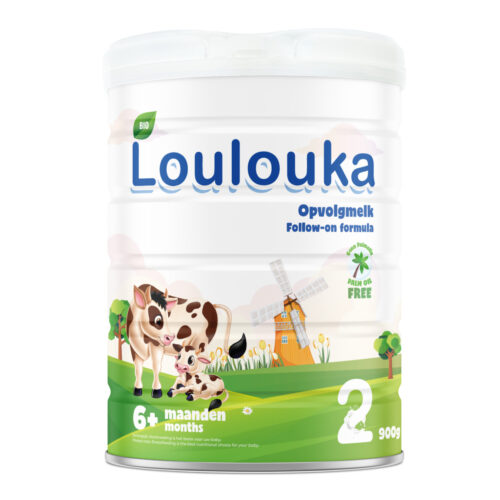
The Loulouka Stage 2 Organic Baby Milk formula is a Swiss baby product that provides a high quality formula for your baby. There is no American version currently on the market. This organic cow’s milk-based formula has a long shelf-life, and an amazing list of ingredients.
Stage 2 is designed for ages 6-12 months, and has a higher iron content their Stage 1 product.
What I Like
The ingredient list is astounding. No US-based formula brand offers quite the same ingredients as the Loulouka formula, including milk from Swiss organic cows. Any Swiss infant formula or food product must comply with European Union regulations, so your baby will reap these benefits in this wonderful formula (source). However, because it can not be purchased from the company directly, exercise caution when choosing a third-party retailer (source).
Here’s what this infant formula does NOT contain: gluten, soy, corn syrup, or palm oil. While the package doesn’t specifically indicate it, the product is most likely n0n-GMO. Switzerland has a moratorium in place on GMOs until 2025 (source). No label is necessary because genetically modified foods are not allowed in any of their products.
The main benefit of this formulat is its first ingredient, non-fat milk. It also has de-mineralized whey powder, which is easier for babies to digest. For fats, it includes coconut, rapeseed, and sunflower oils. These are easier for babies to digest, and promote weight gain.
In addition, Loulouka formula also has LCP, or omega-3 and omega-6 fatty acids, both of which are important for brain growth. This differs from most American baby formulas which add DHA or ARA instead.
Babies will benefit from the abundant vitamins and nutrients added for a complete nutritional profile. It also has choline and inositol, typically in only seen premium baby formulas. Add in whey for easier digestion, and you have a powerful formula!
Lastly, this formula uses sunflower lecithin as an emulsifier which is actually nutritious, unlike the soy lecithin found in other baby formulas.
What I Don’t Like
The only thing not to like about this formula is the lack of prebiotics or probiotics. Many formula companies are beginning to understand the health benefits including of these ingredients for digestion and gut health.
Because it is imported from Switzerland, it will cost more. Also, shipment times may be prolonged or delayed.
HiPP Stage Pre Organic Combiotic Infant Milk Formula
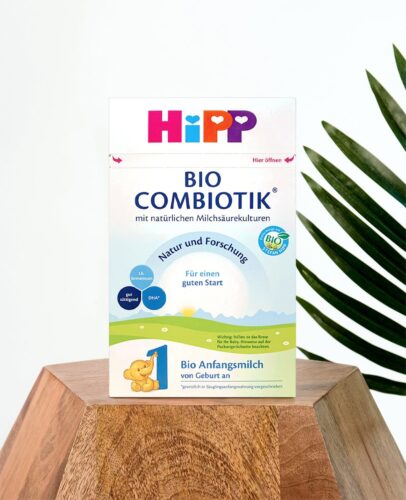
The German HIPP International brand makes superior formulas with quality ingredients. With the HiPP Stage Pre Organic Combiotic Infant Milk Formula, you get a composition close to that of breast milk. It contains all of the nutrients your baby needs while adhering to the strict European Union regulations.
Stage Pre is intended for ages 0 to 6 months.
What I Like
Not only is this formula designed to mimic breastmilk, but it’s actually made with a natural lactic acid culture extracted from real breastmilk! All this, plus the formula is organic!
This formula is non-GMO, and free of pesticides, herbicides, antibiotics, hormones, or fake ingredients. It is also free of gluten, soy, and peanuts. There are no added sugars such as corn or rice syrup, glucose, fructose, or sucrose.
Instead, the formula uses lactose, what naturally occurs in breastmilk, for easier digestion. Furthermore, the Hipp combiotic line specifically contains probiotics, prebiotics, and fish oil to ensure that your baby thrives. It even has galacto-oligosaccharides as one of the prebiotics, similar to breastmilk. GFO helps to protect babies from infections, and boosts their immune system.
In addition, the formula provides LCP’s for brain growth. There is a full list of vitamins and minerals to give your baby a nutrient boost.
When compared to other infant formulas, however, the protein content is much lower. That said, this formula will still help your baby grow, and give him or her a healthy start in life.
Babies should have no problem digesting the organic skimmed milk, whey protein, and lactose.
This formula also has lower levels of aluminum. For years, many infant formulas have had higher that optimal levels of aluminum (source). The manufacturer has found a way to limit exposure to this potentially harmful contaminant.
What I Don’t Like
While I’d prefer whole instead of skimmed milk, this is standard in the majority of cow’s milk-based infant formulas on the market. Fats are added in the form of omega-3 and omega-6 fatty acids.
Furthermore, the formula lacks inositol. This isn’t a deal-breaker but definitely is nice to add as it can help to regulate moods and reduce respiratory distress syndrome in infants.
Compare Organic Baby Formulas
The table below compares only the recommended products on this page. A low or high Price means it is low or high compared to the other products listed. The Popularity Score reflects how often readers click on and buy the product. The Quality Score is our assessment of the overall performance and satisfaction with the product compared to others in the table.
FAQs – Organic Baby Formula
What kind of water should you use for baby formula?
Any clean tap or bottled water is acceptable. To be sure it is safe and free of pathogens, well water must be tested regularly. If you’re concerned about bacteria in your municipal water due to a water main break or other problem, boil it first. Then, quickly cool it before mixing it with powdered infant formula. If there is a problem with lead or other contaminants in your local water supply, do NOT boil it or use this water to prepare infant formula. In these situations, bottled water is much safer. Fluoride, very important for dental health, should also be considered. If your municipality does not add fluoride to its water, your pediatrician will prescribe a supplement at the six month old well visit.
How often should baby bottles be sterilized?
Bottles and nipples should be sterilized prior to the first use. While you may feel more comfortable sterilizing these items at least occasionally, the CDC recommends regularly doing so for preemies and infants under age three months (source). At any age, however, it is important to clean bottles and nipples after feedings. Using a dishwasher or hand-washing in hot, soapy water should be sufficient.
What is the best organic baby formula for colic?
Experienced Mommy recommends Earth’s Best Organic Gentle Baby Formula for babies with tummy problems. The protein is partially hydrolyzed, making it easier to digest.
What is the best organic baby formula for reflux?
Experienced Mommy recommends Earth’s Best Organic Gentle Baby Formula for babies with tummy problems. Although thickened infant formula may be recommended by a doctor for some infants with gastroesophageal reflux disease, there are no organic versions currently on the market.
What is the best organic baby formula that’s most like breastmilk?
Experienced Mommy recommends several excellent organic baby formulas, but suggests that Earth’s Best Organic Infant Formula tastes closest to breastmilk. Other excellent options are HappyBaby Organic Infant Formula Milk-Based Powder with Iron and Gerber Natura Organic Infant Formula with Iron.
Is a liquid formula better than a powder?
Powdered, concentrated liquid, and ready-to-feed infant formulas are all nutritionally equivalent. They differ in regards to convenience, cost, and shelf life. The powdered version, of course, has the longest shelf-life.
Ingredients to Avoid
When choosing the best organic baby formula for your little one, try to avoid the following ingredients:
Maltodextrin. Maltodextrin is basically sugar and a glycemic destabilizer.
Synthetic nutrients. No one likes synthetics! Avoid synthetic nutrients like lycopene, taurine, nucleotides, l-carnitine, and l-methionine. Soy infant formulas often contain these ingredients to increase the amount of protein (source). This is because soy protein isolate alone does not meet the ESPGHAN protein requirements for infant formulas. Europe has banned the use of these ingredients in their organic baby formulas.
Soy or soy-based products. The discussion of whether or not soy has a significant phytoestrogen effect is ongoing (source). Unfortunately, for families who follow a plant-based diet, milk-free infant formula options are limited.
Carrageenan. This ingredient is a thickening agent extracted from seaweed commonly added to infant formulas and non-dairy milk. There is concern that it may cause inflammation of the intestines (source). Like the synthetic nutrients listed above, Europe has banned the use of carrageenan in their organic baby formulas. Unfortunately, it is still present in many baby formulas produced in the US.
GMOs. Non-genetically modified baby formulas are what you want to purchase. Fortunately, those that are labeled organic are also non-GMO!
Synthetic Preservatives or Stabilizers. Keep an eye out for ascorbic palmitate, a fat-soluble form of vitamin C that is frequently added to cosmetics.
Synthetic DHA and ARA. Unlike the naturally occurring DHA and ARA found in breastmilk, commercially-made versions are created from a specific type of algae or fungus. Hexane, a petroleum-based solvent, may be used in the processing of these fatty acids. Most domestically produced infant formulas contain this form of DHA or ARA, and finding alternatives can be difficult. Fortunately, hexane cannot be detected in the final formula products, so they are still considered safe.
Added sugars. Added sugars are no good! Avoid ingredients such as brown rice or any other syrup, corn sugar, maltodextrin, sugar, and syrup solids.
